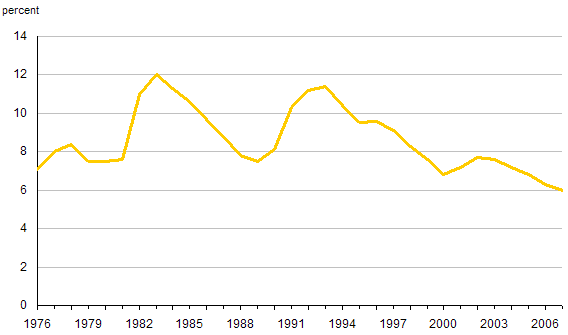Publications
The Canadian Labour Market at a Glance
Unemployment rates
Archived Content
Information identified as archived is provided for reference, research or recordkeeping purposes. It is not subject to the Government of Canada Web Standards and has not been altered or updated since it was archived. Please "contact us" to request a format other than those available.
Employment gains outpaced rising participation in 2007, pushing the unemployment rate down to a 32-year low
-
Because of substantial gains in employment, the monthly unemployment rate fell to 5.8% in the fall of 2007, its lowest level in 32 years, before rebounding slightly to end the year at 6.0%. For the year, the unemployment rate averaged 6.0%, down 0.3 percentage points from 6.3% in 2006.
-
In 2007, an average of 1.1 million people were unemployed each month. Nearly 9 out of 10 unemployed people were looking for work, while the remainder were not because they were waiting for a recall (7.3%) or a new job to start (5.2%).
-
During the recession of the early 1980s, the unemployment rate jumped, increasing from 7.6% in 1981 to 12.0% in 1983. This is the highest rate registered over the last three decades. The peak in the unemployment rate in the recession of the early 1990s was slightly lower, 11.4%, in 1993.
-
Because employment recovered at a snail's pace after the recession of the early 1990s, the decline in the unemployment rate was delayed until 1994. However, strong employment growth from 1997 to 2000 did much to drive down the unemployment rate. By January 2000, it was at 6.7%. It then edged back up, climbing to 8.0% by December 2001, before resuming its decline in September 2003, a trend that continued into 2007.
Chart A.2
Unemployment rates, 1976 to 2007

Source: Statistics Canada, Labour Force Survey, CANSIM table 282-0002.
- Date modified:
